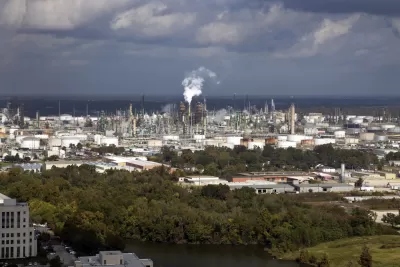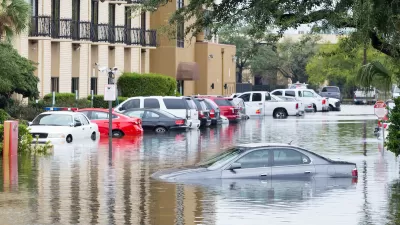Louisiana's chemical plants could release tons of toxic pollution into the air and water during storms, but anti-terrorism provisions make the process of finding risk management information prohibitively difficult.

A new analysis by New Orleans Public Radio (WWNO) and Southerly reveals high levels of risk for Louisiana communities located near the state's coastal chemical plants. The facilities, located in the path of annual hurricanes, emit more air pollution when they shut down in preparation for storms. If damaged by high wind or flooding, the plants run the risk of catastrophic pollution events that can expose wide swaths of the local community to toxic chemicals. The study used EPA data to identify the 30 facilities in the state that store the most toxic materials on site and analyzed the worst-case scenario for each. In ten cases, toxic gases could travel as far as 25 miles from the incident.
Information regarding risk management isn't always easy to come by in the post-9/11 era, with the chemical industry citing the potential for terrorist attacks as a reason to keep their plans closely guarded. To view industry risk management plans, residents have to make an appointment, view plans in person, and only take hand-written notes in the presence of a U.S. Marshal. A spokesperson for Shell, which owns four of the thirty plants in the analysis, would not discuss details but wrote in an email to WWNO that safety is a "top priority," adding that their operations follow strict federal, state, and local regulations.
But the secrecy can have an impact on local communities who can't easily assess the risks to their residents and first responders who lack the information to prepare for emergency scenarios. Emma Cheuse, an attorney with Earthjustice, calls the lack of information a "ticking time bomb" for coastal towns. Earthjustice is suing the EPA for rolling back Obama-era regulatory improvements and pushing for increased transparency and access to risk management information that can protect communities and help them prepare for future disasters.
FULL STORY: 'Ticking Time Bombs': Residents Kept In The Dark About Risks To La.'s Chemical Plants During Storms

Alabama: Trump Terminates Settlements for Black Communities Harmed By Raw Sewage
Trump deemed the landmark civil rights agreement “illegal DEI and environmental justice policy.”

Planetizen Federal Action Tracker
A weekly monitor of how Trump’s orders and actions are impacting planners and planning in America.

How Atlanta Built 7,000 Housing Units in 3 Years
The city’s comprehensive, neighborhood-focused housing strategy focuses on identifying properties and land that can be repurposed for housing and encouraging development in underserved neighborhoods.

In Both Crashes and Crime, Public Transportation is Far Safer than Driving
Contrary to popular assumptions, public transportation has far lower crash and crime rates than automobile travel. For safer communities, improve and encourage transit travel.

Report: Zoning Reforms Should Complement Nashville’s Ambitious Transit Plan
Without reform, restrictive zoning codes will limit the impact of the city’s planned transit expansion and could exclude some of the residents who depend on transit the most.

Judge Orders Release of Frozen IRA, IIJA Funding
The decision is a victory for environmental groups who charged that freezing funds for critical infrastructure and disaster response programs caused “real and irreparable harm” to communities.
Urban Design for Planners 1: Software Tools
This six-course series explores essential urban design concepts using open source software and equips planners with the tools they need to participate fully in the urban design process.
Planning for Universal Design
Learn the tools for implementing Universal Design in planning regulations.
Caltrans
Smith Gee Studio
Institute for Housing and Urban Development Studies (IHS)
City of Grandview
Harvard GSD Executive Education
Toledo-Lucas County Plan Commissions
Salt Lake City
NYU Wagner Graduate School of Public Service





























